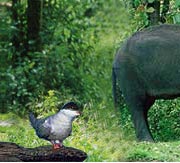 Situated in Sawai Madhopur district of Eastern Rajasthan, the Ranthambhore National Park was once the hunting preserve of the Maharajas of Jaipur. The Ranthambore National Park is bound by river Chambal in the South and river Banas in the North. Ranthambore National park/wildlife sanctuary is one of the important Project tiger reserves in India.
Situated in Sawai Madhopur district of Eastern Rajasthan, the Ranthambhore National Park was once the hunting preserve of the Maharajas of Jaipur. The Ranthambore National Park is bound by river Chambal in the South and river Banas in the North. Ranthambore National park/wildlife sanctuary is one of the important Project tiger reserves in India.There are six man made lakes inside the Ranthambore wildlife sanctuary and form the central focus. In addition to that there are many perennial streams that criss-cross the entire park. Though bound by two rivers in the North and south, the Ranthambore National Park has internal drainage and has no link up with any river system.
Flora in Ranthambore Wildlife Sanctuary
According to estimates, there are around 300 plant species in the Ranthambore National Park. The region receives scanty rainfalls so the vegetation comprises mainly of the dry deciduous type. The most noticeable tree in the Ranthambore wildlife sanctuary is the 'Dhok' (Anogeissus pendula). Other prominent trees in the park are the Banyan (Ficus bengalensis) and Pipal. The tiger reserve has some of the oldest banyan of India. The Neem (Azadirachta indiaca), which is known for its medicinal properties is found in abundance in the Ranthambore National Park.
Some important fruit trees found in the Ranthambore National Park include the Mango (Magnifera indica), Jamun (Syzygium cumini), Ber (Zizyphus mauritania), and Tamarind (Tamarindicus indica also known as Imli). In addition, there are many trees such as palas (Butea monosperma), which sets the forest alight with its bright orange red color. Other important plants in the Ranthambore National Park include the Babul (Accasia nilotica), Gum (Sterculia urens), Kadam (Authocephalus cadamba), Khajur (Phoenix sylvestris), Khair (Accacia catechu), Kikar (Acacia nilotica), Mahua (Madhuca indica), Ronj (Acacia leucophloea) and Tendu (Diospyrous melanoxylon).
Fauna in Ranthambore National Park
Ranthambhore National Park spans an area of about 400 sq km. The tiger is relatively easier to spot in Ranthambhore than in many other National Parks in India. The Ranthambore tiger reserve also supports a large number of other wild species including leopards, jungle cat, hyena, jackal, porcupine, wild boar, sloth bear, marsh crocodile, langur, Indian gazelle, spotted deer, sambar (Asiatic stag) and nilgai (blue bull). The langur is the only primate found in Ranthambhore National Park and is abundant.
Ranthambhore is also home to about 270 species of birds including a large number of migratory birds. Some of the many varieties of birdlife found here are the great Indian horned owl, eagles, parakeets, spoonbills, kingfishers, partridge, quail, storks, owls, geese and ducks. But the most visible bird in Ranthambhore is the peacock, India's National bird.
Safari in Ranthambore National Park
The most exciting aspect of exploring a wildlife sanctuary is the safari into the jungles as the thrill of actually encountering a wild beast in its natural habitat is a great form of adventure and excitement. The Ranthambore National Park is open from October to April and the best time to spot wildlife is the early mornings and evenings. A network of tracks crisscrosses the park. Rides into the Park in open jeeps are pretty safe as most of the wild animals are used to to human presence.
How to Reach Ranthambore
By Air
Jaipur, abouy 4 hrs drive, is the nearest airport. Regular bus services are available between Jaipur and Ranthambore. You can also hire taxi from Jaipur to drive to Ranthambore National Park.
By Road
Sawai Madhopur is the nearest town from Ranthambore (about 11 Km). Sawai Madhopur is well connected to Delhi, Jaipur and Agra.
By Rail/Train
Sawai Madhopur is the nearest Railhead. various trains link Sawai Madhopur to cities such as Jaipur and Delhi.





